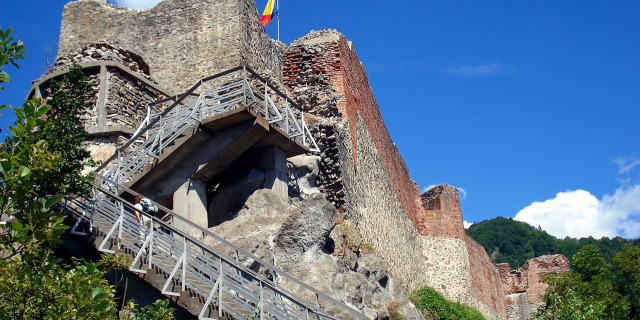Sarmizegetusa Regia (also known as Sarmisegetusa, Sarmisegethusa, Sarmisegethuza; Ancient Greek: Ζαρμιζεγεθούσα, romanized: Zarmizegethoúsa) was the capital and the most important military, religious and political centre of the Dacians before the wars with the Roman Empire. Built on top of a 1200 m high mountain, the fortress, consisting of six citadels, was the core of a strategic and defensive system in the Orăștie Mountains (in present-day Romania).
Sarmizegetusa Regia should not be confused with Ulpia Traiana Sarmizegetusa, the Roman capital of Dacia built by Roman Emperor Trajan some 40 km away, which was not the Dacian capital. Sarmizegetusa Ulpia was discovered earlier, was known already in the early 1900s, and was initially mistaken for the Dacian capital, a confusion which led to incorrect conclusions being made regarding ...Read more
Sarmizegetusa Regia (also known as Sarmisegetusa, Sarmisegethusa, Sarmisegethuza; Ancient Greek: Ζαρμιζεγεθούσα, romanized: Zarmizegethoúsa) was the capital and the most important military, religious and political centre of the Dacians before the wars with the Roman Empire. Built on top of a 1200 m high mountain, the fortress, consisting of six citadels, was the core of a strategic and defensive system in the Orăștie Mountains (in present-day Romania).
Sarmizegetusa Regia should not be confused with Ulpia Traiana Sarmizegetusa, the Roman capital of Dacia built by Roman Emperor Trajan some 40 km away, which was not the Dacian capital. Sarmizegetusa Ulpia was discovered earlier, was known already in the early 1900s, and was initially mistaken for the Dacian capital, a confusion which led to incorrect conclusions being made regarding the military history and organization of the Dacians.
 Zarmizegethusa Regia on Dacia's map from a medieval book made after Ptolemy's Geographia (ca. 140 AD).
Zarmizegethusa Regia on Dacia's map from a medieval book made after Ptolemy's Geographia (ca. 140 AD).Historical records show considerable variation in the spelling of the name of the Dacian capital:[1]
Zarmigethusa, Sarmisegethusa (Ptolemy, Geography, 2nd century AD) Zermizegethusa (Dio Cassius 2nd-3rd century) Sarmazege (Anonymous Geographer from Ravenna, around 700 AD) Sarmategte (Tabula Peutingeriana, 13th century) Zarmizegetusa and Sarmizegetusa (from inscriptions) Sargetia (name of the river nearby)Pre-Roman eraTowards the end of his reign, Burebista transferred the Geto-Dacian capital from Argedava to Sarmizegetusa.[2][3] Serving as the Dacian capital for at least one and a half centuries, Sarmizegethusa reached its zenith under King Decebal. Archeological findings suggest that the Dacian god Zalmoxis and his chief priest had an important role in Dacian society at this time.[4] They have also shed new light on the political, economic and scientific development of the Dacians and their successful assimilation of technical and scientific knowledge from the Greek and Romans.
The site has yielded two especially notable finds:
A medical kit, in a brassbound wooden box with an iron handle, containing a scalpel, tweezers, powdered pumice and miniature pots for pharmaceuticals[5] A huge vase, 24 in (0.6 m) high and 41 in (1.04 m) across, bearing an inscription in the Roman alphabet: DECEBAL PER SCORILO, i.e. ‘Decebalus, son (cf. Latin puer) of Scorilus’ [5] Roman Dacia and Moesia Inferior.
Roman Dacia and Moesia Inferior.The smithies north of the sanctuary also provide evidence of the Dacians' skill in metalworking: findings include tools such as metre-long tongs, hammers and anvils which were used to make some 400 metallic artefacts — scythes, sickles, hoes, rakes, picks, pruning hooks, knives, plowshares, and carpenters' tools [6] — as well as weapons such as daggers, curved Dacian scimitars, spearpoints, and shields.[6]
Nevertheless, the flowering of Dacian civilization apparently underway during the reign of Decebalus came to an abrupt end when Trajan's legions destroyed the city and deported its population.[6]
The defensive systemThe Dacian capital’s defensive system includes six Dacian fortresses — Sarmizegetusa, Costești-Blidaru, Piatra Roșie, Costești-Cetățuie, Căpâlna and Bănița. All six have been named UNESCO World heritage sites.
Roman eraSarmizegetusa's walls were partly dismantled at the end of First Dacian war in AD 102, when Dacia was invaded by the Emperor Trajan of the Roman Empire and rebuilt as Roman fortifications. The latter were subsequently destroyed possibly by the Dacians and then rebuilt again following the successful siege of the site in AD 105–6.[7]
The Roman conquerors established a military garrison at Sarmizegetusa Regia. Later, the capital of Roman Dacia was established 40 km from the ruined Dacian capital, and was named after it - Colonia Ulpia Traiana Augusta Dacica Sarmizegetusa.






























Add new comment